Advertisements
Advertisements
Question
A battery of emf 4 volt and internal resistance 1 Ω is connected in parallel with another battery of emf 1 V and internal resistance 1 Ω (with their like poles connected together). The combination is used to send current through an external resistance of 2 Ω. Calculate the current through the external resistance.
Solution
Let I1 and l2 be the currents through the two branches as shown in the following figure. The current through the 2 Ω resistance will be (I1 + I2) [Kirchhoffs current law].
Applying Kirchhoff's voltage law to loop ABCDEFA, we get,
-2(I1 + I2) - 1(I1) + 4 = 0
∴ 3I1 + 2I2 = 4 .....(1)

Applying Kirchhoff's voltage law to loop BCDEB, we get,
-2(I1 + I2) - 1(I2) + 1 = 0
2I1 + 3I2 = 1 ....(2)
Multiplying Eq. (1) by 2 and Eq. (2) by 3, we get,
6I1 + 4I2 = 8 .....(3)
and 6I1 + 9I2 = 3 ....(4)
Subtracting Eq. (4) from Eq. (3), we get,
- 5I2 = 5
∴ I2 = - 1A
The minus sign shows that the direction of current I2 is opposite to that assumption. Substituting this value of I2 in Eq. (1), we get,
3I1 + 2(-1) = 4
∴ 3I1 - 4 + 2 = 6
∴ I1 = 2A
Current through the 2 Ω resistance = I1 + I2 = 2 - 1 = 1 A.
APPEARS IN
RELATED QUESTIONS
A potentiometer wire has resistance of per unit length of 0.1 Ω/m. A cell of e.m.f. 1.5 V balances against a 300 cm length of the wire. Find the current in the potentiometer wire.
State the principle of working of a potentiometer.
Accuracy of potentiometer can be easily increased by ______.
Figure 3.34 shows a potentiometer circuit for comparison of two resistances. The balance point with a standard resistor R = 10.0 Ω is found to be 58.3 cm, while that with the unknown resistance X is 68.5 cm. Determine the value of X. What might you do if you failed to find a balance point with the given cell of emf ε?
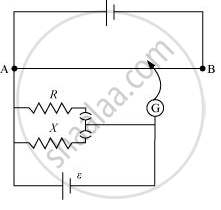
Figure shows a 2.0 V potentiometer used for the determination of internal resistance of a 1.5 V cell. The balance point of the cell in open circuit is 76.3 cm. When a resistor of 9.5 Ω is used in the external circuit of the cell, the balance point shifts to 64.8 cm length of the potentiometer wire. Determine the internal resistance of the cell.
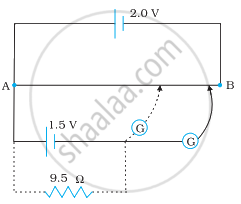
State the advantages of potentiometer over voltmeter.
SI unit of potential gradient is _______.
(a) V cm
(b) `V/"cm"`
(c) Vm
(d) `V/m`
In a potentiometer experiment, balancing length is found to be 120 cm for a cell E1 of emf 2V. What will be the balancing length for another cell E2 of emf 1.5V? (No other changes are made in the experiment.)
In the given circuit, with steady current, calculate the potential drop across the capacitor and the charge stored in it.

(i) State the principle on which a potentiometer works. How can a given potentiometer be made more sensitive?

State the principle of a potentiometer. Define potential gradient. Obtain an expression for potential gradient in terms of resistivity of the potentiometer wire.
Write two possible causes for one sided deflection in a potentiometer experiment.
In the figure a long uniform potentiometer wire AB is having a constant potential gradient along its length. The null points for the two primary cells of emfs ε1 and ε2 connected in the manner shown are obtained at a distance of 120 cm and 300 cm from the end A. Find (i) ε1/ ε2 and (ii) position of null point for the cell ε1.
How is the sensitivity of a potentiometer increased?
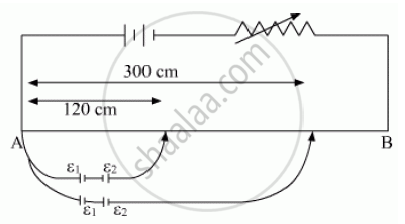
When a resistor of 5Ω is connected across the cell, its terminal potential difference is balanced by 150 cm of potentiometer wire and when a resistance of 10 Ω is connected across the cell, the terminal potential difference is balanced by 175 cm same potentiometer wire. Find the balancing length when the cell is in open circuit and the internal resistance of the cell.
Would you prefer a voltmeter or a potentiometer to measure the emf of a battery?
The net resistance of an ammeter should be small to ensure that _______________ .
In a potentiometer experiment, the balancing length with a resistance of 2Ω is found to be 100 cm, while that of an unknown resistance is 500 cm. Calculate the value of the unknown resistance.
Draw a labelled circuit diagram of a potentiometer to measure the internal resistance ‘r’ of a cell. Write the working formula (derivation is not required).
Define or describe a Potentiometer.
How is potential gradient measured? Explain.
Find the equivalent resistance between the terminals of A and B in the network shown in the figure below given that the resistance of each resistor is 10 ohm.
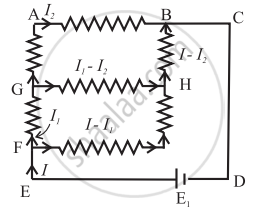
The emf of a cell is balanced by a length of 120 cm of a potentiometer wire. When the cell is shunted by a resistance of 10 Ω, the balancing length is reduced by 20 cm. Find the internal resistance of the cell.
When the null point is obtained in the potentiometer, the current is drawn from the ______
If the potential gradient of a wire decreases, then its length ______
A cell of e.m.f 1.5V and negligible internal resistance is connected in series with a potential meter of length 10 m and the total resistance of 20 Ω. What resistance should be introduced in the resistance box such that the potential drop across the potentiometer is one microvolt per cm of the wire?
Which of the following instruments is not a direct reading instrument?
Two cells having unknown emfs E1 and E2 (E1 > E2) are connected in potentiometer circuit, so as to assist each other. The null point obtained is at 490 cm from the higher potential end. When cell E2 is connected, so as to oppose cell E1, the null point is obtained at 90 cm from the same end. The ratio of the emfs of two cells `("E"_1/"E"_2)` is ______.
The potentiometer is more sensitive, when ______.
The resistivity of potentiometer wire is 40 × 10-8 ohm - metre and its area of cross-section is 8 × 10-6 m2. If 0.2 ampere current is flowing through the wire, the potential gradient of the wire is ______.
Select the WRONG statement:
A potentiometer wire of Length 10 m is connected in series with a battery. The e.m.f. of a cell balances against 250 cm Length of wire. If length of potentiometer wire is increased by 1 m, the new balancing length of wire will be ____________.
To determine the internal resistance of a cell by using potentiometer, the null point is at 1 m when cell is shunted by 3 Ω resistance and at a length 1.5 m when cell is shunted by 6 Ω resistance. The internal resistance of the cell is ______.
Sensitivity of a given potentiometer can be decreased by ______.
Two students X and Y perform potentiometer experiment separately and null point was obtained as shown in diagram. During the experiment, ______.
- X increases the value of R (resistance)
- Y decreases the value of S (resistance)
The position of null point obtained by students X and Y respectively.
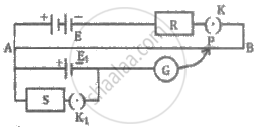
A student connected the circuit as shown in the figure to determine the internal resistance of a cell E1 by potentiometer (E > E1). He is unable to obtain the null point because ______.
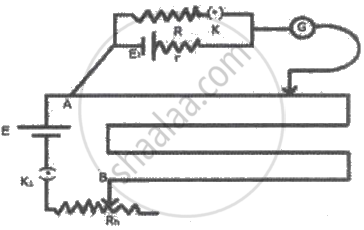
It is observed in a potentiometer experiment that no current passes through the galvanometer when the terminals of the cell are connected across a certain length of the potentiometer wire. On shunting the cell by a 2 Ω resistance, the balancing length is reduced to half. The internal resistance of the cell is ______.
A potentiometer is an accurate and versatile device to make electrical measurements of E.M.F. because the method involves ______.
In a potentiometer of 10 wires, the balance point is obtained on the 7th wire. To shift the balance point to 9th wire, we should ______.
AB is a wire of potentiometer with the increase in the value of resistance R, the shift in the balance point J will be ______.
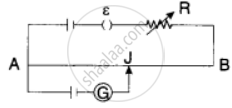
The best instrument for accurate measurement of EMF of a cell is ____________.
AB is a wire of potentiometer with the increase in value of resistance R, the shift in the balance point J will be:

The conductivity of super - conductor is
A wire of resistance R is cut into two equal part. There parts are then connected in parallel. The equivalent resistance of the combination will be
What is the current I in the circuit as show in fig.
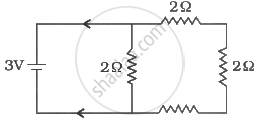
In a potentiometer circuit a cell of EMF 1.5 V gives balance point at 36 cm length of wire. If another cell of EMF 2.5 V replaces the first cell, then at what length of the wire, the balance point occurs?
Consider a simple circuit shown in figure ![]() stands for a variable resistance R′. R′ can vary from R0 to infinity. r is internal resistance of the battery (r << R << R0).
stands for a variable resistance R′. R′ can vary from R0 to infinity. r is internal resistance of the battery (r << R << R0).
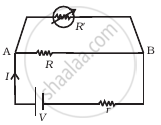
- Potential drop across AB is nearly constant as R ′ is varied.
- Current through R′ is nearly a constant as R ′ is varied.
- Current I depends sensitively on R′.
- `I ≥ V/(r + R)` always.
AB is a potentiometer wire (Figure). If the value of R is increased, in which direction will the balance point J shift?
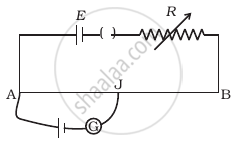
Two cells of same emf but different internal resistances r1 and r2 are connected in series with a resistance R. The value of resistance R, for which the potential difference across second cell is zero, is ______.
If you are provided a set of resistances 2Ω, 4Ω, 6Ω and 8Ω. Connect these resistances so as to obtain an equivalent resistance of `46/3`Ω.
In potentiometer experiment, null point is obtained at a particular point for a cell on potentiometer wire x cm long. If the length of the potentiometer wire is increased without changing the cell, the balancing length will ______. (Driving source is not changed)
What will a voltmeter of resistance 200 Ω read when connected across a cell of emf 2 V and internal resistance 2 Ω?
What is the internal resistance of the cell?
